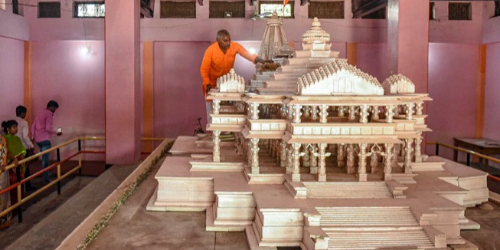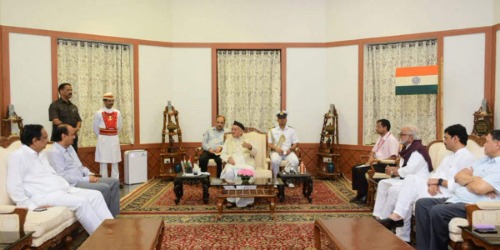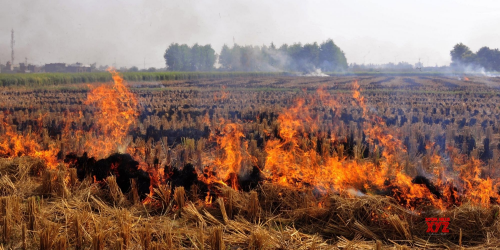Ayodhya set to develop into a far bigger tourism destination after SC verdict

After the landmark Supreme Court judgement on the disputed Ayodhya land, hotel and tourism players are assessing opportunities in the city. The apex court on Saturday ruled that Hindu parties would get 2.77 acres of disputed land, and a trust would be set up by the central government in three months to monitor the construction of the Ram temple in Ayodhya.
Vibhas Prasad, director at homegrown hotels brand Leisure Hotels says that he's planning to pick a heritage property in Ayodhya city which he would like to convert into a boutique hotel with about 25 rooms. "We have been operating as an upscale operator in Uttarakhand, and specifically in tourist destinations like Haridwar, Rishikesh, Badrinath, Kedarnath, Gangotri and Yamunotri. We would like to expand this portfolio as things are looking up in Ayodhya. I am sure the government wants to make it as big as Gujarat's Statue of Unity or even bigger from the tourism standpoint," says Prasad who currently operates 26 properties, including in partnership with Taj Hotels and Club Mahindra Holidays.
Experts say that the tourism sector in the city is expected to get a leg-up after the SC verdict. It's believed that initial investments would come from the tourism sector, and once the temple is constructed, there will be a plenty of business activity which would further boost tourism. While there's some bit of Hindu tourism in Ayodhya, Varanasi and Prayagraj (especially during the Kumbh mela), central and eastern Uttar Pradesh is largely dependent on Buddhist pilgrimage. But that's set to change after the temple is built.
"If you look at mass tourism, the largest segment is spiritual and pilgrimage travel across the country. In Ayodhya, while the market is expected to be skewed towards domestic travelers but there would be some inbound [foreign] tourist potential as well. We expect the city to develop into a far bigger tourism destination with potential for spiritual, social events, business, luxury and MICE [meetings, incentives, conferences and exhibitions] travel over the next three-four years," says a travel consultant.
Of late, the state government has been allocating large funds to develop the tourism market in the city. Recently, the UP government sanctioned about Rs 446 crore for the construction of 725-feet tall Ram statue on the banks of the Saryu River as part of Ram Nagri project. The state government has already approved Rs 640 crore for the development of an international airport over 285 acres at Ayodhya to attract domestic and foreign tourists in large numbers. Having an airport would not only uplift the city's economy but generate higher number of jobs. According to ministry of tourism 2017 report, Uttar Pradesh was the second-most visited state by the domestic tourists after Tamil Nadu.
Spiritual tourism is one of the biggest contributors to the domestic tourism. The role of India as a religious hub for different cultures has helped it attract millions of tourists every year. In 2014/15, the central government launched a dedicated National Mission on Pilgrimage Rejuvenation and Spiritual Heritage Augmentation Drive (PRASHAD) scheme that aimed towards strengthening the infrastructure for tourism across the country.
After the abrogation of Article 370 in Jammu & Kashmir that opened up the tourism opportunities in the hilly state, the latest order from SC is going to galvanise Ayodhya into a tourist hotspot.
Do you think so?
- 417
- Leave a comment
President's Rule In Maharashtra Recommended By Union Cabinet

Maharashtra is set for President's Rule after a report from Governor Bhagat Singh Koshyari to the centre that none of the three parties he had invited since Saturday - BJP, Shiv Sena and Nationalist Congress Party (NCP) - could produce enough numbers to stake claim to power even 20 days after the October 24 state election results. The Governor sent the report after the NCP spoke to him at 11 am, hours before its 8.30 pm deadline, and asked for more time. President's Rule was recommended in the middle of meetings between allies Congress and NCP to discuss support to the Shiv Sena. The NCP of Sharad Pawar received an invite last evening after the Shiv Sena failed to get a three-day extension to stake claim. The Sena has gone to the Supreme Court against the Governor's refusal to give it more time.
Here's your 10-point cheatsheet to this big story:
1. The Shiv Sena's attempts to form a government with its sworn rivals NCP and Congress reached a dead-end yesterday after a call from Congress president Sonia Gandhi gave a glimmer of hope to Sena chief Uddhav Thackeray.
2. At the last minute, when the Shiv Sena was to meet the Governor with letters of support, the Congress said it had taken no decision and would have discussions with NCP chief Sharad Pawar. "From 10 am to 7:30 pm on Monday, our leaders including Sharad Pawar, Praful Patel were waiting for (Congress's) letter," said NCP's Ajit Pawar, Sharad Pawar's nephew.
3. The Shiv Sena went to the Supreme Court complaining that the Governor had refused to grant it even an extra day even though the BJP was given two days to prove its numbers. Senior lawyer Kapil Sibal, a Congress leader, is representing the Sena.
4. Sonia Gandhi sent her top party leaders to Mumbai for discussions on government formation after speaking to Sharad Pawar on the phone this morning. The Congress leaders had earlier put off their visit. Ajit Pawar had told NDTV that his uncle Sharad Pawar had been asked to meet Sonia Gandhi in Delhi instead. Mr Pawar had declined, citing a meeting of NCP MLAs in Mumbai.
5. Though Congress MLAs in Maharashtra favour forming a government with the Sena, the party leadership, especially Sonia Gandhi, is extremely wary of a tie-up with an ideologically different party, a traditional enemy and one with which it was in direct contest in Mumbai and many regions in Maharashtra in the polls. The Congress is also concerned that the Sena's divorce with the BJP, its partner of nearly 30 years, may not be permanent.
6. The Shiv Sena yesterday pulled out its only minister in Prime Minister Narendra Modi's government at the centre to signal its exit from the BJP-led National Democratic Alliance (NDA). The Sena's separation from the BJP was the NCP's prerequisite for talks between the Maharashtra rivals for a non-BJP alliance.
7. The NCP says it will not take any step without its ally Congress. "Whatever decision will be taken will be taken collectively, so we were waiting for Congress response yesterday but it didn't come, we can't decide on it alone. There is no misunderstanding, we are together. The Congress is taking time because we didn't contest with the Shiv Sena," said Ajit Pawar.
8. The Congress says it was Sharad Pawar who wanted more time. Sources say Mr Pawar told Sonia Gandhi yesterday that there was a need to discuss the contours of support to the Sena. "NCP is just two seats short of Sena," Mr Pawar reportedly pointed out, indicating a rethink on whether the Sena should have a full term for its chief minister.
9. On Saturday, as the term of the Maharashtra legislative assembly ended without any resolution, Governor Koshyari invited the BJP to form government. But the BJP opted out of the race accusing the Sena of "betraying the people's mandate".
10. The BJP won 105 seats in the Maharashtra polls and the Sena 56, which placed them comfortably ahead of the majority mark of 145 in the 288-member assembly. But the allies fell out over the Sena's demand for rotational chief ministership, in a "50:50" deal it said was discussed with BJP chief Amit Shah. With the NCP's 54 seats and the Congress's 44, the Sena will have 154 MLAs on its side. Congress MLAs remain at a resort in Rajasthan's Jaipur as the leadership wants to avoid a repeat of Goa, where its members crossed over to the BJP.
Do you agree with this?
Over 80 Punjab Farmers Arrested Over Fires That Smothered Delhi

More than 80 farmers have been arrested in Punjab for starting fires that contributed to the recent pollution crisis in New Delhi and other cities, officials said Thursday.
Each winter the post-harvest burning of crop stubble covers swaths of the region in toxic smog, which combines with car and factory emissions to turn Delhi into the world's most polluted capital.
The Supreme Court this week ordered a crackdown on illegal stubble-burning, but the fires continued across Punjab and Haryana states -- with many started at night to try and avoid detection.
A senior Punjab police officer said more than 17,000 farm fires had been reported in the state in the past three days, with 4,741 on Wednesday alone.
"More than 84 people have been arrested for violating the law. Cases have been filed against 174 farmers," the officer told AFP.
Punjab and Haryana make up a key agricultural region that produces nearly 18 million tonnes of rice each year. This, in turn, creates nearly 20 million tonnes of crop stubble -- most of which is burnt.
Authorities said more than 48,000 farm fires had been reported in the two states since late September -- a dramatic increase from 30,000 cases in 2018.
The Supreme Court ordered a complete stop to the fires on Monday and on Wednesday slammed local governments for not taking action, instructing them to pay hard-up farmers to stop burning the stubble.
"You just want to sit in your ivory towers and rule. You are not bothered and are letting the people die," said Justice Arun Mishra.
Pollution levels in Delhi remained bad on Thursday, four days after one of its worst pollution attacks in several years during which schools were closed and a public health emergency declared.
Dirty air causes hundreds of thousands of premature deaths across cities each year, according to medical studies.
Tiny particles from the fires, which can enter the bloodstream and penetrate the lungs and heart, get blown over Delhi.
Is stubble burning the only option for farmers?
Lawyers Shut Courts, Want Delhi Police Protesters Arrested

The face-off between the lawyers and police of Delhi escalated today with protesting lawyers forcing all the lower courts shut. A lawyer also sent a legal notice to the Delhi police chief for yesterday's marathon protests, insisting it was illegal and the protesters should be arrested within a week. The chairman of the Bar Council of India has assured action against anyone resorting to violence. "The police want full freedom to act against advocates. The police say they would withdraw security of judges and it is one of their demands. To abuse courts is not right," he said. At the Delhi High Court, the lawyers demanded a gag on the media and accused the police of making provocative statements.
Here are the Top 10 developments in this big story:
1. On the third consecutive day of their protest, lawyers have closed the main gates at Patiala House and Saket district courts and did not allow litigants access the court premises. At the Rohini district court, a lawyer doused himself with kerosene and threatened self-immolation. Another advocate climbed the rooftop of one of the buildings in the premises, threatening to commit suicide.
2. Assuring that the courts will function normally from tomorrow, Bar Council chairman Mannan Mishra said action has been taken against the lawyer who slapped a police officer at the Saket Court on Monday. "We are Indians not Pakistanis," he said, then added, "The police did not take action against the Constable who had fired against the advocate".
3. The lawyers claim that one of their colleagues was shot in the chest during Saturday's clash at the Tis Hazari Court, in which more than 20 policemen and eight advocates were injured.
4. "This court should take suo motu action on the provocative statements of the police," Delhi Bar Council Chairman KC Mittal told the High Court. Despite the Bar Council of India Chairman's claim of action agianst thbe advocate who slapped a policemen, he claimed they did not know if the man concerned was an advocate.
5. The Delhi Police told the court that another policeman was beaten up yesterday at Palam.
6. Mr Misra also objected to the police filing two First Information Reports on the violence of Saturday and Monday as the matter was "before the Delhi High Court". "This lodging of FIR cannot be justified. If they are not happy with the High Court order passed on Sunday, they can file a review petition or seek recall of the order," Mr Mishra said.
7. The 11-hour protest by policemen yesterday ended late last evening after action from the police brass following directions by Lieutenant Governor Anil Baijal. Two FIRs were filed for the violence at the Tis Hazari and the Saket courts. A petition will also be filed in the High Court asking it to review yesterday's order of suspension and transfers of the four police officers, top police officers assured.
8. This morning, along with other senior officers, Delhi Police chief Amulya Patnaik met the Lieutenant Governor, who is the Centre's representative in Delhi. The Delhi Police are under the control of the Union Home Ministry.
9. At least 20 policemen and eight lawyers were injured and 20 vehicles were vandalised in Saturday's clash at Tis Hazari court, which started over a wrongly parked vehicle. The attack was followed by another violent confrontation on Monday, when a policeman was slapped and beaten outside Saket District Court by a group of lawyers.
10. Yesterday, at least a thousand policemen gathered outside the police headquarters, blocking an arterial road of the city. The policemen were upset over what they perceived as a lack of the government's concern about their well-being. The protesting officers have submitted a list of 10 demands, which includes the creation of a Police Protection Act.
Should the Delhi Police Protestors be arrested?
Pollution in Delhi 'very poor', but govt claims 12% decline in stubble burning

Even as pollution in Delhi continues to make life difficult for residents, the government has claimed its efforts has led to 12.01% reduction in stubble burning incidents in Haryana, Punjab and Uttar Pradesh. The government, in a statement on Tuesday, said as per ICAR's Creams Laboratory, Uttar Pradesh, Haryana and Punjab have recorded a reduction of 48.2 %, 11.7% and 8.7%, respectively.
The statement said total 31,402 burning events were detected in the three states between October 1 and November 3. As per the statement, concrete steps were taken after directions from the Prime Minister's Office in 2017 to adopt mechanised crop residue management programme.
The scheme, Promotion of Agricultural Mechanisation for In-Situ Management of Crop Residue, was launched with a total outgo of Rs 1,151.8 crore for 2018-19 and 2019-20, wherein the Centre provided subsidised machinery for the management of crop residue.
The government says during 2018-19, it released funds worth Rs 269.38 crore, Rs 137.84 crore and Rs 148.60 crore, to Punjab, Haryana and Uttar Pradesh, respectively. During 2019-20, the government released Rs 273.80 crore, Rs 192.06 crore and Rs 105.29 crore these states.
Despite these claims, the pollution level in Delhi is one of the worst in the world. The Centre's pollution monitoring agency SAFAR said the air quality in Delhi was at 381 (very poor) level on Tuesday while it was at 588 (severe) on Monday.
US space agency National Aeronautics and Space Administration (NASA) has also released satellite images that show a dramatic increase in stubble burning in Punjab and Haryana between October 21 to October 29.



